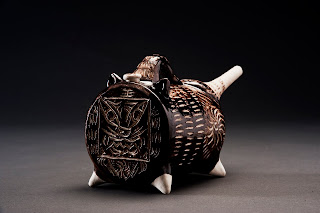
Teaism is a cult founded on the adoration of the beautiful among the sordid, facts of everyday existence. It inculcates purity and harmony, the mystery of mutual charity, the romanticism of the social order. It is essentially a worship of the Imperfect, as it is a tender attempt to accomplish something possible in this impossible thing we know as life.
Kakuzo Okakura
To extract the teapot out of the philosophy of tea is a compelling organic metaphor, isolating the sensual in humanity. Here, I am exploring function not as purpose, but as subject. Although bearing the features of a conventional teapot, this implication questions the practical aspects of its actual function for the sake of more concentrated contemplation on its visual conundrum.
The bellied vessel, along with its handle shaft, is thrown in one piece, indented at the base of the shaft and then joined at the spout. This is difficult to achieve, as the indentation is the weakest point of the piece, balancing the tall shaft in its upright position throughout the entire throwing process.
If you free your mind and look into the sculptural aesthetic, you will see that it signifies the sensibility of a transmuted interaction between the clay and the hands of the sculptor. With the help of a little imagination, you will begin to feel its sensuality.
Written by Sean Lacey
Empatea

The Teapot Song:
I'm a little tea pot,
Short and stout
Here is my handle
Here is my spout
When I get all steamed up,
Hear me shout
Just tip me over and pour me out!
Remember when you learned this childhood rhyme? You not only learned the words, but also pretended that you were a teapot, making gestures and having fun with your imagination. It was, in a sense, putting yourself in another’s shoes, allowing you to share consciousness with a personified being, embracing its figurative form and emotions.
Reading about a feeling or intellectually knowing about one is very different from actually experiencing it yourself. How connected a person is to another, relies very much on the degree to which one is able to feel through the many experiences of life. Empathy begins with living an experience through another person, from their point of view, or in some sense, either figurative or literal, having experienced it oneself.
Based upon the concept of empathy, I hope to extract this intangible element from the human experience. Where as children we took on the form of a teapot, now we lend human experience back to the teapot.
Written by Sean Lacey


